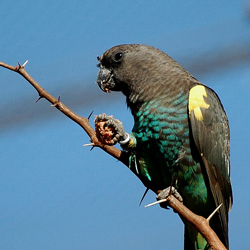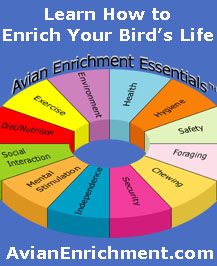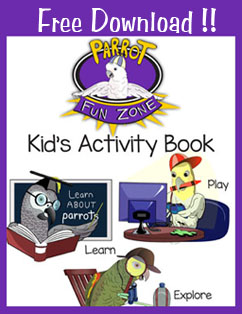| Term | Definition |
|---|---|
| Aggression | (noun) an overt behavior in response to a perceived threat to a bird's territory or mate. Most aggressive behavior is situational and the result of our inability to understand our bird's subtle means of communication. |
| Air sac | (noun) an air-filled space in the body of a bird that forms a connection between the lungs and bone cavities and aids in breathing and temperature regulation. |
| Allopreening | (verb) the action of preening or grooming the skin or feathers of another bird or favorite human. Allopreening in birds is usually directed at the top of the head, a part of the body not easily reached by the recipient. |
| Ambient Attention | (noun) attention given to a parrot without physical contact. For example, while they are in their cage and you are either in the room with them or nearby. This type of attention basically involves initiating and responding to contact calls. |
| Anatomical | (adj) relating to the physical structure of an animal or plant. |
| Anatomy | (noun) the structural makeup of an organism or any of its parts. |
| Arboreal | (adj) of or relating to trees. |
| Archipelago | (noun) a sea or stretch of water containing many islands. |
| Barbule | (noun) a small barb or pointed projection, especially one of the small projections fringing the edges of the barbs of feathers. |
| Bile | (noun) a thick bitter yellow or greenish fluid that is made by the liver that aids in the digestion and absorption of fats in the small intestine. |
| Blood feather | (noun) a "blood feather", sometimes called a "pin feather", is a developingfeather on a bird. This feather can grow as a new feather during the bird's infancy, or grow to replace one from moulting. The pin featherlooks somewhat like a feather shaft. |
| Body language | (noun) a kind of nonverbal communication, where thoughts, intentions, or feelings are expressed by physical behaviors, such as facial expressions, body posture, gestures, eye movement, touch and the use of space. |
| Camouflage | (noun) a method of hiding that allows an otherwise visible animal or object to remain unnoticed, by blending with its environment. |
| Canopy | (noun) refers to the upper level of a forest formed by the tree crowns. |
| Carrion | (noun) the flesh of dead animals. Parrots are not predators but they are opportunistic feeders and have been observed feeding on dead animals. |
| Cavity | (noun) a hollow area within the body (such as the sinuses). |
| Cere | (noun) an area located at the top of a parrot’s beak where a parrot’s nares (nostrils) are located. The cere can be waxy in texture and be different colors, depending on the species of parrot and the time of year. |
| CITES | (noun) The Convention on International Trade in Endangered Species of Wild Fauna and Flora (CITES) is an international agreement between governments. Its aim is to ensure that international trade in specimens of wild animals and plants does not threaten their survival. |
| Cloaca | (noun) a common cavity at the end of the digestive tract for the release of both excretory and genital products in birds. |
| Clutch | (noun) the eggs that a bird lays during one nesting cycle. |
| Cornea | (noun) the transparent (clear) tissue over the front of the eyeball, covering the iris and the pupil. |
| Crest | (noun) the comb or tuft of feathers on the head of a parrot. |
| Crop | (noun) in a bird's digestive system, the crop is an expanded, muscular pouch near the gullet or throat. It is a part of the digestive tract. As with most other organisms that have a crop, the crop is used to temporarily store food. |
| Deforestation | (verb) the act of cutting down trees in forests and rainforests. This is usually done by logging and/or burning the trees, turning the forest into farmlands and savannas. |
| Depth Perception | (noun) the ability to judge the distance of objects and the spatial relationship of objects at different distances. |
| Dimorphic | (adj) occurring in two distinct forms with visual differences between the males and the females. Dimorphic characteristics in parrots may be color, size or distinct markings. |
| Droppings | (noun) term for the waste matter of birds containing both feces and urine. |
| Enrichment | (noun) refers to simple actions we can take to vastly improve their lives in captivity and is an integral part of responsible parrot care. This includes providing toys, a nutritional and varied diet, social interaction and training. |
| Enzymes | (noun) proteins that act as catalysts and help complex reactions necessary for digestion and bodily functions. |
| Exhalation | (noun) the movement of air through the airways to the external environment during breathing. |
| Facilitate | (verb) to make easier or less difficult. |
| Feral | (adj) a previously domesticated animal living in a non-native wild environment after escape or release. |
| Fledge | (verb) the stage in a young bird's life when the feathers and wing muscles are sufficiently developed for flight. Birds are considered to have fledged once they take their first flight. |
| Fledgling | (noun) a young bird that has recently fledged but is still dependent upon parental care and feeding is called a fledgling. |
| Flock | (noun) a group of birds feeding, resting, or traveling together. Flocks can be either single or mixed species. |
| Flourescent | (adj) brilliantly colored and apparently giving off light. |
| Foraging | (verb) the act of searching for food.
|
| Fovea | (noun) a small area of the retina that affords extremely good vision. |
| Gall bladder | (noun) a small organ in the body that aids mainly in the digestion of far and concentrates bile produced by the liver. |
| Habitat | (noun) the environmental area that is inhabited by a species where it can find food, water, shelter, protection and mates. |
| Incubate | (verb) the process of keeping eggs warm and bring them to hatching. |
| Legumes | (noun) a type of plant with seeds that grow in long cases (called pods) Edible seeds from plants in the legume family include beans, peas, lentils, soybeans, and peanuts. They are excellent sources of important minerals and rich in dietary fiber. |
| Lubricate | (verb) to make slippery or smooth. |
| Mandible | (noun) the exterior (outer), projecting part of a bird's mouth, composed of bone covered with a hard keratin shell. |
| Mangrove | (noun) a tree or shrub that grows in muddy, mainly tropical coastal swamps, and typically having numerous tangled roots above ground that form dense thickets. |
| Metabolic Rate | (noun) the amount of energy expended in a given period. |
| Molting | (verb) the replacement of all or part of the feathers. Since feathers cannot heal themselves when damaged, they have to be completely replaced. |
| Mutation | (noun) a change in the genes of a plant or animal that causes physical characteristics that are different from what is normal. |
| Nares | (noun) the nostrils of birds, located on the cere, which is the highest part of a bird’s upper mandible (beak). |
| Nectar | (noun) sugar rich liquid produced by plants. |
| Nectarivore | (noun) an animal which derives its energy and nutrient requirements from a diet consisting mainly or exclusively of the sugar-rich nectar produced by flowering plants. |
| Pantanal | (noun) low-lying wet land with grassy vegetation; usually is a transition zone between land and water. |
| Physiological | (adj) of or relating to the way that the body of a living thing operates. |
| Pollen | (noun) a fine powdery substance, typically yellow, consisting of microscopic grains discharged from the male part of a flower. |
| Predator | (noun) an animal or other organism that hunts and kills other organisms for food. |
| Primates | (noun) any of an order of mammals that are characterized by hands and feet that grasp, a relatively large complex brain, and vision in which objects are seen in three dimensions and that includes human beings, apes, monkeys, and related forms. |
| Pupil | (noun) the colored part of the eye that controls the amount of light that enters into the eye. |
| Regurgitate | (verb) to expel undigested food from the mouth to feed young or mate. |
| Respiration | (noun) the process of inhaling and exhaling; breathing. |
| Roosting | (verb) a period of inactivity similar to sleep for human beings. Most parrots roost as a flock. |
| Sexually dimorphic | (adj) an observable difference between males and female of the same species. |
| Socialization | (noun) the process by which a young parrot learns survival and social skills. |
| Steppes | (noun) large areas of flat grassy land where there are no trees. |
| Toxins | (noun) substances that cause damage to biological systems by chemical means. The term is usually reserved for substances that are life-threatening in small quantities. |
| Transparent | (adj) clear; allowing light to pass through so that objects behind can be distinctly seen. |
| Urate | (noun) a non toxic waste product from the digestive process that is insoluble (does not break down) and uses very little water to excrete (pass). |
| UV Light | (noun) radiation that is in the ultraviolet range; wave lengths shorter than light but longer than X rays. |
| Vent | (noun) the opening of the cloaca where waste passes out of the parrot. The vent is also the opening for release of sperm and the passage of an egg. |
| Vertebrae | (noun) sections of bone or cartilage that make up the spinal column. |
| Vertebrates | (noun) animals having a backbone or spinal column. |





































































